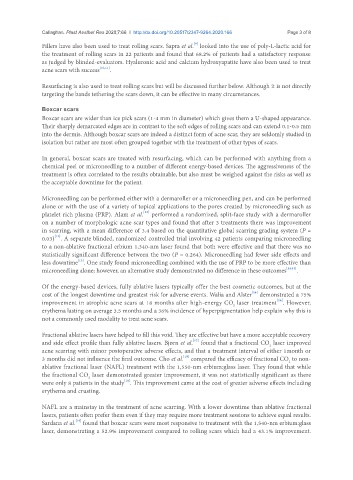Page 781 - Read Online
P. 781
Callaghan. Plast Aesthet Res 2020;7:66 I http://dx.doi.org/10.20517/2347-9264.2020.166 Page 3 of 8
[9]
Fillers have also been used to treat rolling scars. Sapra et al. looked into the use of poly-L-lactic acid for
the treatment of rolling scars in 22 patients and found that 68.2% of patients had a satisfactory response
as judged by blinded-evaluators. Hyaluronic acid and calcium hydroxyapatite have also been used to treat
acne scars with success [10,11] .
Resurfacing is also used to treat rolling scars but will be discussed further below. Although it is not directly
targeting the bands tethering the scars down, it can be effective in many circumstances.
Boxcar scars
Boxcar scars are wider than ice pick scars (1-4 mm in diameter) which gives them a U-shaped appearance.
Their sharply demarcated edges are in contrast to the soft edges of rolling scars and can extend 0.1-0.5 mm
into the dermis. Although boxcar scars are indeed a distinct form of acne scar, they are seldomly studied in
isolation but rather are most often grouped together with the treatment of other types of scars.
In general, boxcar scars are treated with resurfacing, which can be performed with anything from a
chemical peel or microneedling to a number of different energy-based devices. The aggressiveness of the
treatment is often correlated to the results obtainable, but also must be weighed against the risks as well as
the acceptable downtime for the patient.
Microneedling can be performed either with a dermaroller or a microneedling pen, and can be performed
alone or with the use of a variety of topical applications to the pores created by microneedling such as
[12]
platelet rich plasma (PRP). Alam et al. performed a randomized, split-face study with a dermaroller
on a number of morphologic acne scar types and found that after 3 treatments there was improvement
in scarring, with a mean difference of 3.4 based on the quantitative global scarring grading system (P =
[12]
0.03) . A separate blinded, randomized controlled trial involving 42 patients comparing microneedling
to a non-ablative fractional erbium 1,340-nm laser found that both were effective and that there was no
statistically significant difference between the two (P = 0.264). Microneedling had fewer side effects and
less downtime . One study found microneedling combined with the use of PRP to be more effective than
[13]
microneedling alone; however, an alternative study demonstrated no difference in these outcomes [14,15] .
Of the energy-based devices, fully ablative lasers typically offer the best cosmetic outcomes, but at the
cost of the longest downtime and greatest risk for adverse events. Walia and Alster demonstrated a 75%
[16]
[16]
improvement in atrophic acne scars at 18 months after high-energy CO laser treatment . However,
2
erythema lasting on average 3.5 months and a 36% incidence of hyperpigmentation help explain why this is
not a commonly used modality to treat acne scars.
Fractional ablative lasers have helped to fill this void. They are effective but have a more acceptable recovery
and side effect profile than fully ablative lasers. Bjørn et al. found that a fractional CO laser improved
[17]
2
acne scarring with minor postoperative adverse effects, and that a treatment interval of either 1month or
[18]
3 months did not influence the final outcome. Cho et al. compared the efficacy of fractional CO to non-
2
ablative fractional laser (NAFL) treatment with the 1,550-nm erbium:glass laser. They found that while
the fractional CO laser demonstrated greater improvement, it was not statistically significant as there
2
[18]
were only 8 patients in the study . This improvement came at the cost of greater adverse effects including
erythema and crusting.
NAFL are a mainstay in the treatment of acne scarring. With a lower downtime than ablative fractional
lasers, patients often prefer them even if they may require more treatment sessions to achieve equal results.
Sardana et al. found that boxcar scars were most responsive to treatment with the 1,540-nm erbium:glass
[19]
laser, demonstrating a 52.9% improvement compared to rolling scars which had a 43.1% improvement.

